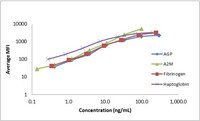RV3MAG-26K MilliporeMILLIPLEX MAP Rat Vascular Injury Magnetic Bead Panel 3 - Toxicity Multiplex Assay
The analytes available for this multiplex kit are: α-1-Acid Glycoprotein (AGP), α-2-Macroglobulin (A2M), and Haptoglobin.
More>> The analytes available for this multiplex kit are: α-1-Acid Glycoprotein (AGP), α-2-Macroglobulin (A2M), and Haptoglobin. Less<<Recommended Products
Áttekintés
| Replacement Information |
|---|
Kulcsspecifikációk táblázata
| Analytes Available | Species Reactivity | Key Applications | Multiplexing Ordering Requirements | Detection Methods |
|---|---|---|---|---|
| α-1-Acid Glycoprotein (AGP) α-2-Macroglobulin (A2M) Haptoglobin The analyte Fibrinogen is no longer available in the panel. | R | Mplex | Please note: Sample Type must be selected when configuring this kit. | Luminex xMAP |
| References |
|---|
| Product Information | |
|---|---|
| Detection method | Luminex xMAP |
| Configuration | Design your multiplex kit by choosing available analytes within this panel. |
| Precision, % |
|
| Multiplex Ordering Requirements | Please note: Sample Type must be selected when configuring this kit. |
| Panel Type | MAGNETIC Toxicity |
| Quality Level | MQ200 |
| Dimensions |
|---|
| Materials Information |
|---|
| Toxicological Information |
|---|
| Safety Information according to GHS |
|---|
| Safety Information |
|---|
| Storage and Shipping Information | |
|---|---|
| Storage Conditions | Recommended storage for kit components is 2 - 8°C. |
| Packaging Information | |
|---|---|
| Material Size | 96-well plate |
| Transport Information |
|---|
| Supplemental Information |
|---|
| Specifications |
|---|
| Global Trade Item Number | |
|---|---|
| Katalógusszám | GTIN |
| RV3MAG-26K | 04055977114720 |
Documentation
Protocols
| Title |
|---|
| Protocol Rat Vascular Injury Magnetic Bead Panel 3 |
| Protocol- RV3MAG-26K |
MILLIPLEX MAP Rat Vascular Injury Magnetic Bead Panel 3 - Toxicity Multiplex Assay MSDS
| Title |
|---|
Brochure
| Title |
|---|
| The Power of Biomarker Analysis |
Technical Info
Posters
| Title |
|---|
| Toxicology in drug discovery and development: Biomarkers and model organisms |







